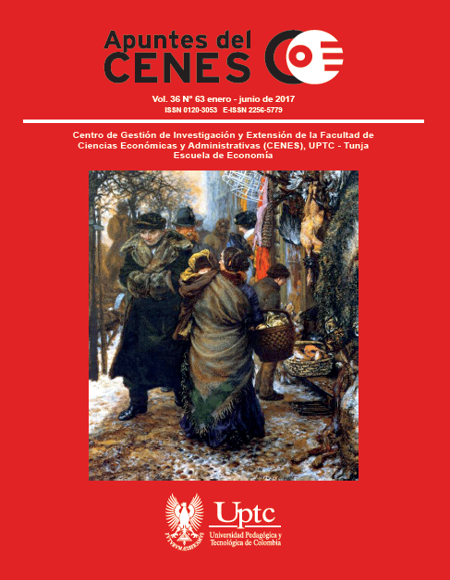Analysis of the Cycles of the Colombian Agricultural GDP 1976-2013

Abstract
The analysis of growth accounting in agricultural sector during 1976–2013 shows a strong contribution of labor factor and TFP, but a low contribution of capital. The results of the cycle estimation using different methods of time series filtering indicate the existence of three complete cycles with duration of 16 quarters (4 years). The expansions remain for 29 quarters on average (9.6 years) and contractions 4 quarters (1 year), which implies that cycles in agricultural sector are asymmetric given the long duration of expansions compared to contractions. The co-movement analysis of the agricultural GDP cycle and each of its demand components shows that aggregate variables of agricultural activity behave procyclically. The strong covariance of GDP with apparent consumption and of coffee exports and trade balance is one of the best stylized facts that have characterized the economic fluctuations in the Colombian agricultural sector during this period.Keywords
economic cycles, total factor productivity, stylized fact, co-movement, GDP.
References
- Ahumada, H. & Garegnani, M. L. (1999, abril). Hodrick–Prescott Filter in Practice. Buenos Aires: Universidad Nacional de La Plata.
- Arango, L., Alfonso, V., Arias, F., Cangrejo, G. & Pulido, J. (2013). Ciclos de negocios en Colombia, 1975-2011. Lecturas de Economía, (78).
- Barro, R. & Sala-i-Martin, X. (2004). Economic Growth. (Second ed.). Cambridge, Massachusetss: The MIT Press.
- Berry, A. (1970). The Development of Colombian Agriculture. New Haven, USA: Yale University, Mimeo.
- Blanchard, O. & Fischer, S. (1986). Lectures on Macroeconomics. Cambridge, Massachusetss: The MIT Press.
- Box, G.E.P. & Jenkins, G. (1976). Time Series Analysis: Forecasting and Control. USA: Holden-Day.
- Burns, A. & Mitchell, W. (1946). Measuring Business Cycles. New York: National Bureau of Economic Research.
- Campbell, J. & Mankiw, N.G. (1987a). Are Output Fluctuations Transitory? Quarterly Journal of Economics 102(4). DOI: https://doi.org/10.2307/1884285
- Grupo de Estudios del Crecimiento Económico (GRECO), Banco de la República. (2004). El crecimiento económico colombiano en el siglo XX. Bogotá: Fondo de Cultura Económica.
- Hayashi, F. & Prescott, E. (2002, February). The 1990s in Japan: a lost Decade. Rev. Econ. Dynamics, 5. DOI: https://doi.org/10.1006/redy.2001.0149
- Hayashi, F. & Prescott, E. (2008). The Depressing Effect of Agricultural Institutions on the Prewar Japanese Economy. Journal of Political Economy, 116(4). DOI: https://doi.org/10.1086/591804
- Hodrick, R. J. & Prescott, E.C. (1980). Postwar U.S. Business Cycles: an Empirical Investigation. Discussion Papers 451. Pittsburgh, USA: Carnegie-Mellon University, Northwestern University.
- Jaramillo, C. F. (2002). Crisis y transformación de la agricultura colombiana 1990–2000. Bogotá: Fondo de Cultura Económica.
- Kalmanovitz, S. & López, E. (2006). La agricultura colombiana en el siglo XX. Bogotá: Fondo de Cultura Económica.
- King, R. & Rebelo, S. (1993). Low Frequency Filtering and Real Business Cycles. Journal of Economic Dynamics and Control, 17(1–2). DOI: https://doi.org/10.1016/S0165-1889(06)80010-2
- King, R. G. & Ross, L. (1994, June). Capital Fundamentalism, Economic Development and Economic Growth. Carnegie –Rochester Conf. Ser. Public Policy, 40. DOI: https://doi.org/10.1016/0167-2231(94)90011-6
- Klenow, P. J. & Rodríguez–Clare, A. (1997). The Neoclassical Revival in Growth Economics: has it gone too far? In B. S. Bernanke & J. Rotemberg (eds.) NBER Macroeconomics Annual. Cambridge, MA: MIT Press. DOI: https://doi.org/10.1086/654324
- Londoño, J. L. (1984). Agricultura y transformación estructural. Una comparación internacional. Revista Planeación y Desarrollo, 21(3 y 4).
- Nelson, C. & Plosser, C. (1982, Sept.). Trends and Random Walks in Macroeconomic Time Series. Journal of Monetary Economics, 10. DOI: https://doi.org/10.1016/0304-3932(82)90012-5
- Ocampo, J. A. (1984). Colombia y la economía mundial, 1830–1910. Bogotá: Siglo XXI.
- Ocampo, J. A. (1991). The Transition from Primary Exports to Industrial Development in Colombia. In M. Blomstrom & P. Mellev (eds.), Diverging Paths. Washington: s.n.
- Okun, A. M. (1962). Potential GNP: its Measurement and Significance. In J. Pechman (ed.) (1983), Economics for Policymaking, Cambridge, MA: MIT Press.
- Prescott, E. (1986). Theory ahead of Business Cycle Measurement. Federal Reserve Bank of Minneapolis Quarterly Review 10(4). DOI: https://doi.org/10.21034/qr.1042
- Ravn, M. & Uhlig, H. (1997). On adjusting the HP-Filter for the Frequency of Observations. Netherlands: Tilburg University Working Paper.
- Solow, R. M. (1957, August). Technical Change and the Aggregate Production Function. The Review of Economics and Statistics, 39(3). DOI: https://doi.org/10.2307/1926047
- Uribe, A.F. (1998). Las grandes transformaciones del sector agropecuario colombiano en la última década: una visión regional. Bogotá: Corpoica.
- Urrutia, M. & Robinson, J. (2007). Economía colombiana del siglo XX. Un análisis cuantitativo. Bogotá: Fondo de Cultura Económica y Banco de la República.
- Zarnowitz, V. (1992, January). Business Cycles: Theory, History, Indicators and Forecasting. Bogotá: University of Chicago Press. DOI: https://doi.org/10.7208/chicago/9780226978925.001.0001
Downloads
Download data is not yet available.
